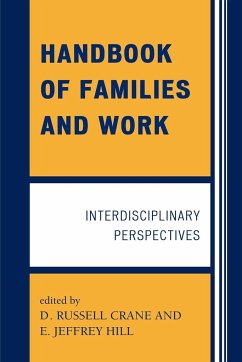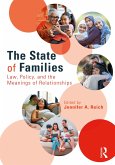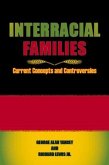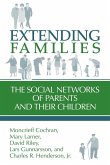Handbook of Families and Work
Interdisciplinary Perspectives
Herausgeber: Crane, D. Russell; Hill, Jeffrey E.
Handbook of Families and Work
Interdisciplinary Perspectives
Herausgeber: Crane, D. Russell; Hill, Jeffrey E.
- Broschiertes Buch
- Merkliste
- Auf die Merkliste
- Bewerten Bewerten
- Teilen
- Produkt teilen
- Produkterinnerung
- Produkterinnerung
This handbook is designed to illuminate issues involved in the intersection of family life and paid employment from a broad range of disciplines. These contributions by leading national and international work-family scholars represent state-of-the-art summaries of work-family research.
Andere Kunden interessierten sich auch für
![Child Welfare Professionals and Incest Families Child Welfare Professionals and Incest Families]() Child Welfare Professionals and Incest Families53,99 €
Child Welfare Professionals and Incest Families53,99 €![Noteworthy Families (Modern Science) ; An Index to Kinships in Near Degrees between Persons Whose Achievements Are Honourable, and Have Been Publicly Recorded Noteworthy Families (Modern Science) ; An Index to Kinships in Near Degrees between Persons Whose Achievements Are Honourable, and Have Been Publicly Recorded]() Francis GaltonNoteworthy Families (Modern Science) ; An Index to Kinships in Near Degrees between Persons Whose Achievements Are Honourable, and Have Been Publicly Recorded16,99 €
Francis GaltonNoteworthy Families (Modern Science) ; An Index to Kinships in Near Degrees between Persons Whose Achievements Are Honourable, and Have Been Publicly Recorded16,99 €![A GUIDE TO BUILDING GENERATIONAL WEALTH IN EAST AFRICAN FAMILIES A GUIDE TO BUILDING GENERATIONAL WEALTH IN EAST AFRICAN FAMILIES]() Kakurah NinsiimaA GUIDE TO BUILDING GENERATIONAL WEALTH IN EAST AFRICAN FAMILIES20,99 €
Kakurah NinsiimaA GUIDE TO BUILDING GENERATIONAL WEALTH IN EAST AFRICAN FAMILIES20,99 €![The State of Families The State of Families]() The State of Families68,99 €
The State of Families68,99 €![Interracial Families Interracial Families]() George Alan YanceyInterracial Families42,99 €
George Alan YanceyInterracial Families42,99 €![Wellbeing of Transnational Muslim Families Wellbeing of Transnational Muslim Families]() Wellbeing of Transnational Muslim Families55,99 €
Wellbeing of Transnational Muslim Families55,99 €![Extending Families Extending Families]() Moncrieff CochranExtending Families52,99 €
Moncrieff CochranExtending Families52,99 €-
-
-
This handbook is designed to illuminate issues involved in the intersection of family life and paid employment from a broad range of disciplines. These contributions by leading national and international work-family scholars represent state-of-the-art summaries of work-family research.
Produktdetails
- Produktdetails
- Verlag: University Press of America
- Seitenzahl: 528
- Erscheinungstermin: 16. Juli 2009
- Englisch
- Abmessung: 229mm x 152mm x 31mm
- Gewicht: 848g
- ISBN-13: 9780761844358
- ISBN-10: 076184435X
- Artikelnr.: 25855114
- Herstellerkennzeichnung
- Libri GmbH
- Europaallee 1
- 36244 Bad Hersfeld
- gpsr@libri.de
- Verlag: University Press of America
- Seitenzahl: 528
- Erscheinungstermin: 16. Juli 2009
- Englisch
- Abmessung: 229mm x 152mm x 31mm
- Gewicht: 848g
- ISBN-13: 9780761844358
- ISBN-10: 076184435X
- Artikelnr.: 25855114
- Herstellerkennzeichnung
- Libri GmbH
- Europaallee 1
- 36244 Bad Hersfeld
- gpsr@libri.de
D. Russell Crane is Director of the Comprehensive Clinic and Professor of Marriage and Family Therapy, School of Family Life, Brigham Young University. He recently received the American Association for Marriage and Family Therapy Cumulative Contributions to Marriage and Family Therapy Research Award. He is the author of Fundamentals of Marital Therapy, co-edited Handbook of Families and Health: Interdisciplinary Perspectives and Handbook of Families and Poverty, and more than fifty scholarly articles and book chapters. E. Jeffrey Hill is Associate Professor in the School of Family Life at Brigham Young University. His research examines finding harmony between paid work and family life. He has authored more than forty scholarly articles and book chapters on this topic. Previously, he was a work and family subject matter expert at IBM, where he pioneered many flexible work options including: paternity leave, part-time employment, and telecommuting.
Editors' Introduction by E. Jeffrey Hill and M. Russell Crane
Part 1: Exploring the Work-Family Interface
Job Demands, Spousal Support, and Work-Family Balance: A Daily Analysis of
the Work-Family Interface
Working Families Under Stress: Socially Toxic Time Cages and Convoys
The Effects of Job Stress on the Family: One Size Does Not Fit All
How Family-Supportive Work Environments and Work-Supportive Home
Environments Can Reduce Work-Family Conflict and Enhance Facilitation
Reducing Conceptual Confusion: Clarifying the Positive Side of Work and
Family
The Intersection of Work and Family Demands and Resources: Linking
Mechanisms and Boundary-Spanning Strategies
Work and Family Health in a Global Context
When Employees Must Choose Between Work and Family: Application of
Conservation of Resources Theory
Part 2: Focus on Flexible Work Arrangements Workplace Flexibility:
Implications for Worker Health and Families
Flexibility and Control: Does One Necessarily Bring the Other?
Flexible Work Arrangements: Help or Hype?
Part 3: Working Fathers, Working Mothers, Working Spouses, Working
Grandparents
Work and Family Conditions that Give Rise to Fathers' Knowledge of
Children's Daily Activities
What Gives When Mothers Are Employed? Parental Time Allocation in
Dual-Earner and Single-Earner Two-Parent Families
Maternal Employment and Child Development
Mothers' Shiftwork: Effects on Mothers, Fathers, and Children
To Work and To Love: Bi-directional Relationships between Job Conditions
and Marriage
The Interaction between Marital Relationships and Retirement
Parental Employment and Child Development: Variation by Child, Family, and
Job Characteristics
Generation and Gender in the Workplace: A New Generation at Work
Living through Work; Working through Life
Work-Family Facilitation: What Does It Look Like
Part 1: Exploring the Work-Family Interface
Job Demands, Spousal Support, and Work-Family Balance: A Daily Analysis of
the Work-Family Interface
Working Families Under Stress: Socially Toxic Time Cages and Convoys
The Effects of Job Stress on the Family: One Size Does Not Fit All
How Family-Supportive Work Environments and Work-Supportive Home
Environments Can Reduce Work-Family Conflict and Enhance Facilitation
Reducing Conceptual Confusion: Clarifying the Positive Side of Work and
Family
The Intersection of Work and Family Demands and Resources: Linking
Mechanisms and Boundary-Spanning Strategies
Work and Family Health in a Global Context
When Employees Must Choose Between Work and Family: Application of
Conservation of Resources Theory
Part 2: Focus on Flexible Work Arrangements Workplace Flexibility:
Implications for Worker Health and Families
Flexibility and Control: Does One Necessarily Bring the Other?
Flexible Work Arrangements: Help or Hype?
Part 3: Working Fathers, Working Mothers, Working Spouses, Working
Grandparents
Work and Family Conditions that Give Rise to Fathers' Knowledge of
Children's Daily Activities
What Gives When Mothers Are Employed? Parental Time Allocation in
Dual-Earner and Single-Earner Two-Parent Families
Maternal Employment and Child Development
Mothers' Shiftwork: Effects on Mothers, Fathers, and Children
To Work and To Love: Bi-directional Relationships between Job Conditions
and Marriage
The Interaction between Marital Relationships and Retirement
Parental Employment and Child Development: Variation by Child, Family, and
Job Characteristics
Generation and Gender in the Workplace: A New Generation at Work
Living through Work; Working through Life
Work-Family Facilitation: What Does It Look Like
Editors' Introduction by E. Jeffrey Hill and M. Russell Crane
Part 1: Exploring the Work-Family Interface
Job Demands, Spousal Support, and Work-Family Balance: A Daily Analysis of
the Work-Family Interface
Working Families Under Stress: Socially Toxic Time Cages and Convoys
The Effects of Job Stress on the Family: One Size Does Not Fit All
How Family-Supportive Work Environments and Work-Supportive Home
Environments Can Reduce Work-Family Conflict and Enhance Facilitation
Reducing Conceptual Confusion: Clarifying the Positive Side of Work and
Family
The Intersection of Work and Family Demands and Resources: Linking
Mechanisms and Boundary-Spanning Strategies
Work and Family Health in a Global Context
When Employees Must Choose Between Work and Family: Application of
Conservation of Resources Theory
Part 2: Focus on Flexible Work Arrangements Workplace Flexibility:
Implications for Worker Health and Families
Flexibility and Control: Does One Necessarily Bring the Other?
Flexible Work Arrangements: Help or Hype?
Part 3: Working Fathers, Working Mothers, Working Spouses, Working
Grandparents
Work and Family Conditions that Give Rise to Fathers' Knowledge of
Children's Daily Activities
What Gives When Mothers Are Employed? Parental Time Allocation in
Dual-Earner and Single-Earner Two-Parent Families
Maternal Employment and Child Development
Mothers' Shiftwork: Effects on Mothers, Fathers, and Children
To Work and To Love: Bi-directional Relationships between Job Conditions
and Marriage
The Interaction between Marital Relationships and Retirement
Parental Employment and Child Development: Variation by Child, Family, and
Job Characteristics
Generation and Gender in the Workplace: A New Generation at Work
Living through Work; Working through Life
Work-Family Facilitation: What Does It Look Like
Part 1: Exploring the Work-Family Interface
Job Demands, Spousal Support, and Work-Family Balance: A Daily Analysis of
the Work-Family Interface
Working Families Under Stress: Socially Toxic Time Cages and Convoys
The Effects of Job Stress on the Family: One Size Does Not Fit All
How Family-Supportive Work Environments and Work-Supportive Home
Environments Can Reduce Work-Family Conflict and Enhance Facilitation
Reducing Conceptual Confusion: Clarifying the Positive Side of Work and
Family
The Intersection of Work and Family Demands and Resources: Linking
Mechanisms and Boundary-Spanning Strategies
Work and Family Health in a Global Context
When Employees Must Choose Between Work and Family: Application of
Conservation of Resources Theory
Part 2: Focus on Flexible Work Arrangements Workplace Flexibility:
Implications for Worker Health and Families
Flexibility and Control: Does One Necessarily Bring the Other?
Flexible Work Arrangements: Help or Hype?
Part 3: Working Fathers, Working Mothers, Working Spouses, Working
Grandparents
Work and Family Conditions that Give Rise to Fathers' Knowledge of
Children's Daily Activities
What Gives When Mothers Are Employed? Parental Time Allocation in
Dual-Earner and Single-Earner Two-Parent Families
Maternal Employment and Child Development
Mothers' Shiftwork: Effects on Mothers, Fathers, and Children
To Work and To Love: Bi-directional Relationships between Job Conditions
and Marriage
The Interaction between Marital Relationships and Retirement
Parental Employment and Child Development: Variation by Child, Family, and
Job Characteristics
Generation and Gender in the Workplace: A New Generation at Work
Living through Work; Working through Life
Work-Family Facilitation: What Does It Look Like









